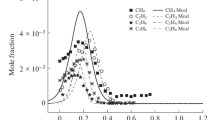Abstract
One-dimensional laminar premixed benzene-oxygen-argon flames with equivalence ratios of 2, 1, and 0.7, stabilized at low pressure (45 mbar) on a flat flame burner are studied. Gas sampling is performed by a conical quartz nozzle, at different positions in the flames. Identification and monitoring of chemical species is performed by gas chromatography. These measurements should complete experimental data on rich and sooting benzene flames available in the literature and will be of particular help for further improvements of benzene oxidation mechanisms. A comparison of experimental results with data simulated with the use of two recent kinetic models highlights their inability to predict stoichiometric and lean benzene combustion.
Similar content being viewed by others
References
D. W. Dockery, C. A. Pope, X. Xu, J. D. Spengler, J. H. Ware, M. E. Fay, B. G. Ferris, and F. E. Speizer, “An association between air pollution and mortality in six U.S. cities,” New Engl. J. Med., 329, 1753–1759 (1993).
K. Siegmann and H. C. Siegmann, Current Problems in Condensed Matter, Plenum Press, New York (1998), pp. 143–160.
C. S. McEnally, L. D. Pfefferle, B. Atakan, and K. Kohse-Höinghaus, “Studies of aromatic hydrocarbon formation mechanisms in flames: Progress towards closing the fuel gap,” Prog. Energy Combust. Sci., 32, 247–294 (2006).
J. D. Bittner and J. B. Howard, “Composition profiles and reaction mechanisms in a near sooting premixed benzene/oxygen/argon flame,” Proc. Combust. Inst., 18, 1105–1116 (1981).
J. D. Bittner, “A molecular beam mass spectrometry study of fuel-rich and sooting benzene-oxygen flames,” Ph.D. Thesis, Dept of Chemical Engineering, Massachusetts Institute of Technology (1981).
F. Defoeux, V. Dias, C. Renard, P. J. Van Tiggelen, and J. Vandooren, “Experimental investigation of the structure of a sooting premixed benzene/oxygen/argon flame burning at low pressure,” Proc. Combust. Inst., 30, 1407–1415 (2005).
B. Yang, Y. Li, L. Wei, C. Huang, J. Wang, Z. Tian, R. Yang, L. Sheng, Y. Zhang, and F. Qi, “An experimental study of the premixed benzene/oxygene/argon flame with tunable synchrotron photoionization,” Combust. Flame, 31, 555–563 (2007).
V. Detilleux and J. Vandooren, “Molecular beam mass spectrometry analysis of PAH production pathways in C6H6/O2/Ar and C6H6/C2H2/O2/Ar flames,” Combust. Sci. Technol., 180, 1347–1369 (2008).
D. A. Bittker, “Detailed mechanism of oxidation of benzene,” Combust. Sci. Technol., 79, 49–72 (1991).
J. L. Emdee, K. Brezinsky, and I. Glassman, “A kinetic model for the oxidation of toluene near 1200 K,” J. Phys. Chem., 96, 2151–2161 (1992).
R. P. Lindstedt and G. Skevis, “Detailed kinetic modeling of premixed benzene flames,” Combust. Flame, 99, 551–561 (1994).
H.-Y. Zhang and J. T. McKinnon, “Elementary reaction modeling of high-temperature benzene combustion,” Combust. Sci. Technol., 107, 261–300 (1995).
Y. Tan and P. Frank, “A detailed comprehensive kinetic model for benzene oxidation using recent kinetic results,” Proc. Combust. Inst., 26, 677–684 (1996).
M. U. Alzueta, P. Glarborg, and K. Dam-Johan-sen, “Experimental and kinetic study of the oxidation of benzene.” Int. J. Chem. Kinet., 32, 498–522 (2000).
A. Ristori, P. Dagaut, A. El Bakali, G. Pengloan, and M. Cathonnet, “Benzene oxidation: Experimental results in a JDR and comprehensive kinetic modeling in JSR, shock-tube and flame,” Combust. Sci. Technol., 167, 223–256 (2001).
H. Richter and J. B. Howard, “Formation and consumption of single-ring aromatic hydrocarbons and their precursors in premixed acetylene, ethylene and benzene flames,” Phys. Chem. Chem. Phys., 4, 2038–2055 (2002).
N. Kunioshi, S. Komori, and S. Fukutani, “Numerical analysis of the effect of acetylene and benzene addition to low-pressure benzene-rich flat flames on polycyclic aromatic hydrocarbons formation,” Combust. Flame, 147, 1–10 (2006).
G. L. Agafonov, I. Naydenova, P. A. Vlasov, and J. Warnatz, “Detailed kinetic modeling of soot formation in shock tube pyrolisis and oxidation of toluene and n-heptane,” Proc. Combust. Inst., 31, 575–583 (2007).
N. M. Marinov, W. J. Pitz, C. K. Westbrook, M. J. Castaldi, and S. M. Senkan, “Modeling of aromatic and polycyclic aromatic hydrocarbon formation in premixed methane and ethane flames,” Combust. Sci. Technol., 116, 211–287 (1996).
M. J. Castaldi, N. M. Marinov, C. F. Melius, S. M. Senkan, W. J. Pitz, and C. K. Westbrook, “Experimental and modeling investigation of aromatic and polycyclic aromatic hydrocarbon formation in a premixed ethylene flame,” Proc. Combust. Inst., 26, 693–702 (1996).
C. F. Melius, M. E. Colvin, N. M. Marinov, W. J. Pitz, and S. M. Senkan, “Reaction mechanisms in aromatic hydrocarbon formation involving cyclopentadienyl moiety,” Proc. Combust. Inst., 26, 685–692 (1996).
M. Frenklach, “Reaction mechanism of soot formation in flames,” Phys. Chem. Chem. Phys., 4, 2028–2037 (2002).
C. Venkat, K. Brezinsky, and I. Glassman, “High temperature oxidation of aromatic hydrocarbons,” Proc. Combust. Inst., 19, 143–152 (1982).
G. Bermudez and L. D. Pfefferle, “Laser ionisation time-of-flight mass spectrometry combined with residual gas analysis for the investigation of moderate temperature benzene oxidation,” Combust. Flame, 100, 41–51 (1995).
Y. Chai and L. D. Pfefferle, “An experimental study of benzene oxidation at fuel-lean and stoichiometric equivalence ratio conditions,” Fuel, 77, 313–320 (1998).
J. H. Kent, “A noncatalytic coating for platinum-rhodium thermocouples,” Combust. Flame, 14, 279–281 (1970).
COSILAB®, The Combustion Simulation Laboratory Version 2.0.8. Rotexo GmbH & Co. KG. Haan, Germany (2007); www.SoftPredict.com.
L. K. Madden, L. V. Moskaleva, S. Kristyan, and M. C. Lin, “Ab initio MO study of the unimolecular decomposition of the phenyl radical,” J. Phys. Chem. A, 101, 6790–6797 (1997).
Author information
Authors and Affiliations
Corresponding author
Additional information
__________
Translated from Fizika Goreniya i Vzryva, Vol. 45, No. 4, pp. 53–66, July–August, 2009.
Rights and permissions
About this article
Cite this article
Detilleux, V., Vandooren, J. Experimental study and kinetic modeling of benzene oxidation in one-dimensional laminar premixed low-pressure flames. Combust Explos Shock Waves 45, 392–403 (2009). https://doi.org/10.1007/s10573-009-0049-x
Received:
Revised:
Published:
Issue Date:
DOI: https://doi.org/10.1007/s10573-009-0049-x




